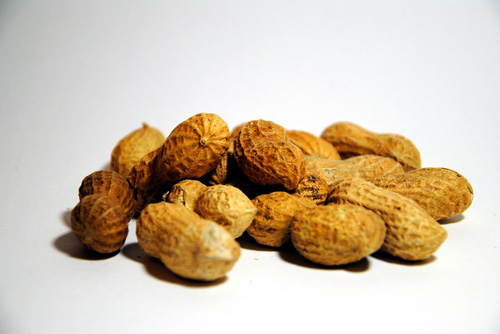
The peanut (Arachis Hipogaea L.) probably originates from Latin America, (Argentina and Brazil) countries where it is still cultivated today. From here it spread to all tropical and subtropical climates. Today, it is a very important agricultural resource for countries such as Africa, India, China and even the United States. Peanut oil is extracted from the seed by means of solvents. The crude oil has a deep yellow color. After the refining process, the color is a pale yellow. Peanut oil remains fluid at room temperature, while at low temperatures it tends to veil and form light stearin deposits. According to the regulations in force, the oil must meet the requirements indicated in the following technical data sheet:
| CARATTERISTICA | REQUISITI | METODO DI ANALISI | |
|---|---|---|---|
| Relative density at a 20/20°C | from 0,912 to 0,920 | See A.1.1 | |
| Refractive index nD at 40°C | from 1,460 to 1,465 | See A.1.2 | |
| Number of iodine | from 84 to 107 | See A.1.3 | |
| Content in sterols mg / kg | from 900 to 2900 | See A.1.5 | |
| Acidity, expressed as oleic acid,% | max 0,5 | See A.1.6 | |
| Number of peroxides, meq oxygen / kg | max 7,0 | See A.1.7 | |
| Impurities (petroleum ether)% | max 0,05 | UNI EN ISO 663 | |
| Soaps, expressed as sodium oleate, mg / kg | max 10 | See A.1.8 | |
| Metals, mg / kg (**) | |||
| iron | max 1,5 | UNI EN ISO 8294 | |
| copper | max 0,1 | UNI EN ISO 8294 | |
| lead (1) | max 0,1 | UNI EN ISO 12193 | |
| arsenic | max 0,1 | See A.2.1 | |
| Solvents, mg / kg (***) | |||
| hexane | max 1 | ||
| CARATTERI ORGANOLETTICI | |||
| smell and taste | Delicate flavor characteristic of the oil, free from anomalous or unpleasant odors or tastes | ||
| appearance | clear 20°C | ||
| color | the spectrophotometric absorptions, measured on diluted oil with the same volume of hexane, in a 1 cm tray, with reference to normal hexane, must not exceed the values of 0.20 and 0.10 respectively at 420 and 453 nm | ||
| Permitted additives and relative limits | According to current legislation (2) | ||
| Aromatic polycyclic hydrocardides | According to CE 333/07 and subsequent amendments | ||
| Composition of fatty acids, GLC (capillary),% ISO 5508 | Composition of sterols, GLC (capillary),% See A.1.4 | ||
| CHARACTERISTIC | REQUIREMENTS | CHARACTERISTIC | REQUIREMENTS |
| C12:0 - Lauric Acid | ND - 0,1 | Cholesterol | ND - 1,0 |
| C14:0 - Myristic acid | ND - 0,1 | Brassicasterolo | ND - 0,2 |
| C16:0 - Palmitic acid | from 5,0 to 14,0 | 24-Methylene cholesterol | § |
| C16:1 - Palmitoleic acid * | ND - 0,2 | Campesterol | from 12,0 to 19,8 |
| C17:0 - Heptadecenoic acid | ND - 0,1 | Campestanol | § |
| C17:1 - Heptadecenoic acid | ND - 0,1 | Stigmasterolo | 5,4 to 13,2 |
| C18:0 - Stearic acid | from 1,0 to 4,5 | Delta 7 - Campesterol | § |
| C18:1 - Oleic acid * | from 35,0 to 76,0 | Delta 5.23 - Stigmastadienol | § |
| C18:2 - Linoleic acid | from 8,0 to 43,0 | Clerosterol | § |
| C18:3 - Linoleic acid | ND - 0,3 | Beta - sitosterol | from 47,4 to 69,0 |
| C20:0 - Arachic acid | from 0,5 to 2,0 | Sitostanol | § |
| C20:1 - Eicosenoic acid | from 0,7 to 3,0 | Delta5 - Avenasterolo | from 4,5 to 18,8 |
| C20:2 - Eicosadienoic acid | ND | Delta 7.9 (0.11) - Stigmastadienol | § |
| C22:0 - Behenic acid | from 1,5 to 4,5 | Delta 5.24 - Stigmastadienol | § |
| C22:1 - Erucic acid | ND - 0,3 | Delta 7 - Stigmastenol | ND - 1,0 |
| C22:2 - Docosadienoic acid | ND | Delta7 - Avenasterol | ND - 1,5 |
| C24:0 - Lignoceric acid | from 0,5 to 2,5 | ||
| C24 :1 - Tetracosenoic acid | ND - 0,3 |
* Sum of positional isomers which may or may not be separated under the test conditions
** Codex Alimentarius
*** Law Decree n. 64/1993
(1) EC Regulation 466 of 08/03/2001
(2) At the date of publication of this standard, the D.M. n. 209 – 27.2.1996, (Official Gazette no. 96 – 24.4.1996)
§ The components indicated with § and for which no limit value has been set must not be taken into consideration for the purity assessment.
NORMATIVE REQUIREMENTS
ISO 5508 – Animal and Vegetable fats and oils – Analysis by gaschromatografy of methilesthers of fatty acids
ISO 5509 – Animal and Vegetable fats and oils – Preparation of methyl esters of fatty acids
UNI EN ISO 663 – Vegetable and animal oils and fats – Determination of the content of insoluble impurities
UNI EN ISO 8294 – vegetable and animal oils and fats – Determination of the content of copper, iron and nickel. Method for atomic absorption spectrometry with a graphite furnace.
UNI EN ISO 12193 – Vegetable and animal oils and fats – Determination of lead content. Method for atomic absorption spectrometry with a graphite furnace.
APPENDIX (information)
A BIBLIOGRAPHY
A.1 NGD REFERENCE METHODS (GRASS STANDARDS AND DERIVATIVES)
A.1.1 NGD C18- Determination of the relative density
A.1.2 NGD C31 – Determination of the refractive index
A.1.3 NGD C32- Determination of the iodine number according to Wijs
A.1.4 NGD C71 – Determination of sterol composition by capillary column gas chromatography
A.1.5 NGD C72 – Determination of sterol content by capillary column gas chromatography
A.1.6 NGD C10 – Determination of acidity
A.1.7 NGD C35 – Determination of the number of peroxides
A.1.8 NGD C8 – Determination of soaps
A.2 OTHER REFERENCE METHODS
A.2.1 AOAC 963.21 – 1990 Arsenic in food. Kjeldahl Flask Digestion. Final action.
AOAC 952.13- 1990 Arsenic in food. Silver Diethyldithiocarbamate method. Final action.


